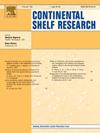Hotspots of human impact on the seafloor in the Southwestern Baltic Sea
IF 2.1
3区 地球科学
Q2 OCEANOGRAPHY
引用次数: 0
Abstract
The Southwestern Baltic Sea is a notable example of intense human impact on the seafloor in a confined shallow marine environment. Various marks left by dredging, dumping, fishing, anchoring, among others, reflect the different pressures on the seafloor. These activities represent cumulative stressors for marine ecosystems, potentially leading to habitat modification or loss. Characterizing and quantifying the extent of the different pressures is essential for understanding the system and evaluating the environmental status outlined by different legal frameworks. Here, the effects of different human activities on the seafloor in exemplary hotspots in the SW Baltic Sea are visualized and assessed. Actual anthropogenic marks are compared with assessments based on commonly accessible regional and local information from remote sensing data and institutional sources. About 36% of the seafloor of the investigated area is influenced, mainly by bottom trawling, propeller scouring, anchoring, and dumping. More than 91% of the human footprint corresponds to trawl marks, mainly affecting soft substrates. In addition, from 15% to 47% of the seafloor is disturbed in selected ‘detail areas' within the hotspots. Comparisons with indirect data used for regional pressure estimation demonstrate how hydroacoustic data can enhance assessments of seabed physical pressures. However, quantitative comparisons are challenging, especially when information on human activities is limited or when seafloor recovery rates in relation to the frequency of anthropogenic pressures are unknown.
人类对波罗的海西南部海底影响的热点
波罗的海西南部是人类在有限的浅海环境中对海底造成强烈影响的一个显著例子。挖泥、倾倒、捕鱼、锚泊等活动留下的各种痕迹,反映了海底受到的不同压力。这些活动是海洋生态系统的累积压力源,可能导致栖息地的改变或丧失。描述和量化不同压力的程度对于了解系统和评估不同法律框架所概述的环境状况至关重要。在这里,不同的人类活动对波罗的海西南部典型热点地区的海底的影响进行了可视化和评估。将实际的人为标记与基于通常可获得的来自遥感数据和机构来源的区域和地方信息的评估进行比较。调查区域约36%的海底受到影响,主要受底拖网、螺旋桨冲刷、锚泊和倾倒的影响。超过91%的人类足迹对应于拖网痕迹,主要影响软基材。此外,在热点区域内选定的“细节区域”,15%至47%的海底受到干扰。与用于区域压力估计的间接数据的比较表明,水声数据如何能够加强对海底物理压力的评估。然而,定量比较是具有挑战性的,特别是当关于人类活动的资料有限或海底恢复率与人为压力频率的关系未知时。
本文章由计算机程序翻译,如有差异,请以英文原文为准。
求助全文
约1分钟内获得全文
求助全文
来源期刊

Continental Shelf Research
地学-海洋学
CiteScore
4.30
自引率
4.30%
发文量
136
审稿时长
6.1 months
期刊介绍:
Continental Shelf Research publishes articles dealing with the biological, chemical, geological and physical oceanography of the shallow marine environment, from coastal and estuarine waters out to the shelf break. The continental shelf is a critical environment within the land-ocean continuum, and many processes, functions and problems in the continental shelf are driven by terrestrial inputs transported through the rivers and estuaries to the coastal and continental shelf areas. Manuscripts that deal with these topics must make a clear link to the continental shelf. Examples of research areas include:
Physical sedimentology and geomorphology
Geochemistry of the coastal ocean (inorganic and organic)
Marine environment and anthropogenic effects
Interaction of physical dynamics with natural and manmade shoreline features
Benthic, phytoplankton and zooplankton ecology
Coastal water and sediment quality, and ecosystem health
Benthic-pelagic coupling (physical and biogeochemical)
Interactions between physical dynamics (waves, currents, mixing, etc.) and biogeochemical cycles
Estuarine, coastal and shelf sea modelling and process studies.
 求助内容:
求助内容: 应助结果提醒方式:
应助结果提醒方式:


